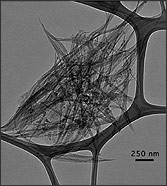Scientists today have no problem making a variety of nanometer objects - wires, tubes, strips and even tree-like shapes. However, sometimes they fail to explain exactly how these structures are formed in the liquid or gaseous environment in which they are obtained.

Now, a research team led by the chemist Song Jin from the University of Wisconsin, reports in an article published in the prestigious scientific journal Science, that a simple defect in the crystal known as a "screw dislocation" is what drives the growth of hollow zinc oxide nanotubes with a thickness of A millionth of a centimeter.
The finding is important because it provides new insight into the process that guides the creation of today's smallest synthetic structures, a significant challenge in nanoscience and nanotechnology. "We believe that this research provides a broad theoretical basis for controlling the growth of nanowires or nanotubes without the need for metallic catalysts, a basis that can be adapted to many materials," says the lead researcher.
Such materials and miniaturized structures, which the scientists manage to prepare, have already found a multitude of applications in the fields of electronics, solar energy, batteries, laser technologies and biological or chemical sensing. By further expanding the theory underlying the formation of such tiny structures, it will now be possible for scientists to develop new methods for the industrial production of nanoscale objects by using a variety of different materials.
The new method is based on what the scientists call the Borgian step. Deviations - twisted deviations - are fundamental to the growth and properties of all crystalline materials. As the name suggests, these defects encourage the creation of helical segments, in the absence of which a perfect crystal is obtained. As soon as atoms "land" on the surface of the crystal, they form a structure that is remarkably similar in shape to the winding slopes in multi-level parking structures. In their previous study, the scientists showed that such anomalies drive the growth of one-dimensional nanowire structures that look like tiny pine trees. This, says the lead researcher, is an essential clue to understanding the kinetics of independent growth of nanotubes.
The key to understanding the ability to harness these defects to prepare nanostructures in a normal way, the researcher explains, is knowing that when atoms accumulate due to a curved abnormality on the surface, tension builds up in the expanding tiny structures. It turns out that "the formation of hollow or twisted structures are two of the most effective ways to relieve this structural tension," explains the researcher. "In some cases, the existence of a large strain energy, which originates from the structural defect within the nanomaterials, dictates the independent formation of hollow nanotubes around the defects."
The phenomenon described by University of Wisconsin scientists is fundamentally different from other normal mechanisms for the formation of hollow nanostructures. Today, scientists use templates to design nanotubes, or as an alternative to diffusion processes to convert one material into another, hollow material. Today, carbon nanotubes are produced by folding a single layer that closes on itself. The described mechanism, the researchers explain, should also be suitable for materials other than zinc oxide: "Understanding the formation of nanotubes will certainly help us understand similar phenomena in other materials."
In the end, the new knowledge obtained could help to develop cheap and commercial production methods of nanomaterials for a wide variety of applications. The most promising field, says the lead researcher, is the field of renewable energy where it will be possible to deploy large amounts of these nanomaterials to convert sunlight into electricity, as well as provide new raw materials for battery electrodes, and other thermo-electronic devices.
